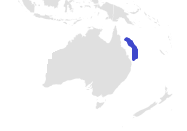Tropical sawshark facts for kids
Quick facts for kids Tropical sawshark |
|
|---|---|
 |
|
| Conservation status | |
| Scientific classification | |
| Genus: |
Pristiophorus
|
| Species: |
delicatus
|
 |
|
| Range of the Tropical sawshark | |
| Synonyms | |
|
Pristiophorus peroniensis Yearsley, Last & White, 2008 |
|
The tropical sawshark (Pristiophorus delicatus) is a unique type of sawshark. It was only recently discovered and described by scientists. Before it had its official name, people called it Pristiophorus sp. B.
This special shark lives only in the waters off northeastern Australia. You can find it deep down on the upper part of the continental slope near Queensland. It lives at depths between 246 and 405 meters (about 807 to 1,329 feet).
Its scientific name, delicatus, comes from a Latin word meaning "delicate." This name refers to the very fine teeth found on its long, saw-like snout, which is called a rostrum.
Contents
What Does the Tropical Sawshark Look Like?
The tropical sawshark is a small species. Female sharks can grow up to 85 centimeters (about 33 inches) long. Males are usually smaller, reaching about 63 centimeters (about 25 inches).
This shark has a slender body that is round in the middle. Its body flattens out a bit near its gill slits. The most noticeable part is its long, saw-like snout. This snout gets narrower towards the end.
Its Unique Snout and Face
The snout has many very thin teeth along its sides. These teeth are of different lengths. It also has a pair of thin, flat feelers called barbels. These barbels help the shark find food.
The tropical sawshark has large, oval-shaped eyes. Its nostrils are located about one-third of the way from its mouth to where the barbels attach to the snout. The shark's mouth is wide and curved.
It has many rows of teeth inside its mouth. The teeth have flat, oval bases and a single, sharp point.
Fins and Coloration
The shark's pectoral fins are large with rounded tips. The back edges of these fins are slightly curved inwards. It has two dorsal fins that are far apart. The first dorsal fin is longer and wider than the second one.
The caudal fin, or tail fin, is short. It does not have a lower lobe. The shark's back is medium brown, and its belly is white. The back edges of its dorsal and tail fins are clearly white. Its paired fins are mostly pale, but their bases are brownish.
Where Does the Tropical Sawshark Live?
The tropical sawshark is endemic to northeastern Australia. This means it is found only in this specific area. It lives off the coast of Queensland, south of the Samaurez Reef.
It prefers to live in deep waters on the upper continental slope. This is a part of the ocean floor that slopes down from the continent.
Conservation Status
Scientists do not know much about the life of the tropical sawshark. However, its small size might mean it can have many babies. This would help its population grow.
There is not much fishing in the areas where this shark lives. Because of this, the World Conservation Union has classified it as a species of Least Concern. This means it is not currently at high risk of disappearing.
See also
 In Spanish: Pristiophorus delicatus para niños
In Spanish: Pristiophorus delicatus para niños


